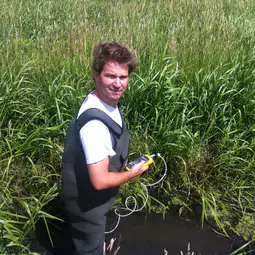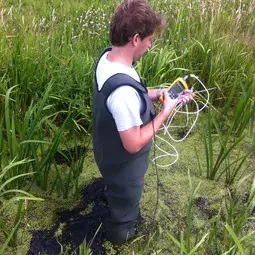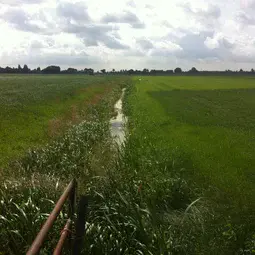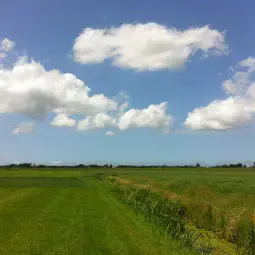Fishing meets science with waders and smartphones
Dutch and American researchers have developed waders equipped with temperature sensors that enable fly-fishers to find the best fishing locations while collecting data to help scientists study streams. The research is published today (29 February) in Geoscientific Instrumentation, Methods and Data Systems, an open access journal of the European Geosciences Union.
“As scientists, we hope these data help us better understand where groundwater enters streams and where streamwater drains away to the groundwater,” explains Rolf Hut, a hydrologist at the Delft University of Technology and lead author of the study. “Furthermore, fly fishers themselves could benefit from knowing local stream temperature to find optimal fishing locations.”
The team’s idea, which emerged from a conversation between Hut and Scott Tyler from the University of Nevada, is simple: equip waders with low-cost sensors that measure water temperature and send the readings to the wearer’s GPS-equipped smartphone via Bluetooth. Anglers could use this data right away and move to locations in the stream likely to have more fish. At the same time, the phone can upload both GPS location and temperature information to a central database, making it available to hydrologists.
“In just the USA alone, an estimated 27 million recreational anglers regularly fish in freshwater streams and lakes,” says Tim van Emmerik, a hydrologist at Delft University of Technology and co-author of the GI study. “Imagine if they were all equipped with a temperature-sensing wader! This would mean a constant supply of new, accurate data, which can be used to estimate water quality and quantity, fish ‘hotspots’, and overall state of the ecosystem.”
Since interactions between ground- and surface water are complex and vary widely between different streams, scientists need sensors measuring hydrological data at various points along various streams to better study them. “Ultimately, good understanding of stream dynamics helps us advise policies that better balance multiple use of streamwater: as a natural habitat for plants and animals, and as a human drinking resource and place for recreation,” explains Hut.
After walking around in prototype temperature-sensing waders at a poster hall of the European Geosciences Union General Assembly last April, Hut and his colleagues did precise field and lab experiments to test and calibrate their waders.
Hut walked around a stream in the Dutch countryside with the prototype and compared the water temperature measured by the sensor in his waders to that collected by a reference thermometer. Back in the lab, the team tested how long it took for the waders to change temperature when exposed to a drop or rise in temperature, and how heat emanating from the wearer’s leg would influence the measurements.
“We have now demonstrated that this prototype is capable of measuring the type of temperature changes we are interested in,” says Hut. “It works!”
The next step is to discuss with manufacturers of waders how to best incorporate sensors in them. The team also want to reach out to fishing enthusiasts, conservation groups and school students to get as many people as possible to wear the temperature-sensing waders.
“This work really is an example of how relatively simple measurement devices can be fused with existing equipment to actively involve communities in gathering scientific data,” concludes van Emmerik. “It’s becoming a trend to find ways to incorporate ‘alternative’ communities in science. Whether it’s school kids or fishermen, studies like ours demonstrate that everyone can be a scientist.”
###
Please mention the name of the publication (Geoscientific Instrumentation, Methods and Data Systems) if reporting on this story and, if reporting online, include a link to the paper (http://www.geosci-instrum-method-data-syst.net/5/45/2016/) or to the journal website (http://www.geoscientific-instrumentation-methods-and-data-systems.net).
More information
This research is presented in the paper ‘Proof of concept: temperature sensing waders for environmental sciences’ published in the EGU open access journal Geoscientific Instrumentation, Methods and Data Systems on 29 February 2016.
Citation: Hut, R., Tyler, S., and van Emmerik, T.: Proof of concept: temperature-sensing waders for environmental sciences, Geosci. Instrum. Method. Data Syst., 5, 45-51, doi:10.5194/gi-5-45-2016, 2016.
The team is composed of R. Hut (Chair of Water Resources Engineering, Department of Water Management, Civil Engineering and Geosciences, Delft University of Technology [TU Delft], the Netherlands), S. Tyler (Department of Geological Sciences and Engineering, University of Nevada, US), and T. van Emmerik (TU Delft).
The European Geosciences Union (EGU) is Europe’s premier geosciences union, dedicated to the pursuit of excellence in the Earth, planetary, and space sciences for the benefit of humanity, worldwide. It is a non-profit interdisciplinary learned association of scientists founded in 2002. The EGU has a current portfolio of 17 diverse scientific journals, which use an innovative open access format, and organises a number of topical meetings, and education and outreach activities. Its annual General Assembly is the largest and most prominent European geosciences event, attracting over 11,000 scientists from all over the world. The meeting’s sessions cover a wide range of topics, including volcanology, planetary exploration, the Earth’s internal structure and atmosphere, climate, energy, and resources. The EGU 2016 General Assembly is taking place in Vienna, Austria, from 17 to 22 April 2016. For information about meeting and press registration, please check http://media.egu.eu, or follow the EGU on Twitter and Facebook.
If you wish to receive our press releases via email, please use the Press Release Subscription Form at http://www.egu.eu/news/subscribe/. Subscribed journalists and other members of the media receive EGU press releases under embargo (if applicable) 24 hours in advance of public dissemination.
Geoscientific Instrumentation, Methods and Data Systems (GI) is an open-access interdisciplinary electronic journal for swift publication of original articles and short communications in the area of geoscientific instruments. It covers three main areas: (i) atmospheric and geospace sciences, (ii) earth science, and (iii) ocean science. A unique feature of the journal is the emphasis on synergy between science and technology that facilitates advances in GI.
Contact
Rolf Hut
Researcher at Delft University of Technology
Delft, the Netherlands
Phone +31-15-2784909
Email r.w.hut@tudelft.nl
Twitter: @RolfHut
Tim van Emmerik
PhD student at Delft University of Technology
Delft, the Netherlands
Phone +31-15-2787346
Email T.H.M.vanEmmerik@tudelft.nl
Twitter: @TimVanEmmerik
Scott W. Tyler
Professor of Hydrogeology
University of Nevada, Reno, US
Phone +1-775-784-6250
Email styler@unr.edu
Bárbara Ferreira
EGU Media and Communications Manager
Munich, Germany
Phone +49-89-2180-6703
Email media@egu.eu
EGU on Twitter: @EuroGeosciences
Links
- Scientific paper
- Journal – Geoscientific Instrumentation, Methods and Data Systems
- Interview with Rolf Hut and Tim van Emmerik on the EGU blog, GeoLog
- Read this press release in simplified language, aimed at 7–13 year olds, on our Planet Press site





